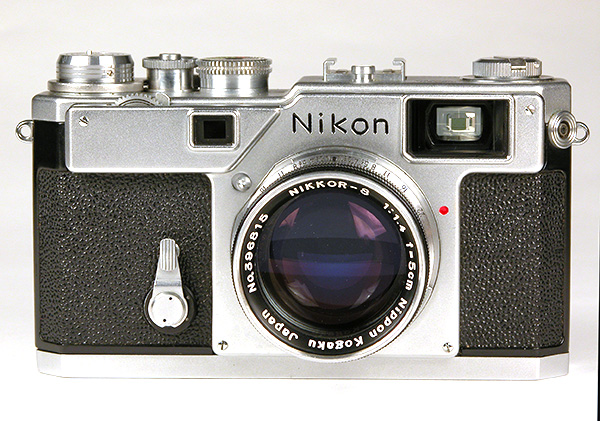
Nikon S3 With Nikkor 50mm f1.4 Lens

The Nikon S3 is a simplified version of Nikon's flagship SP model. Both are professional quality 35mm rangefinder cameras as usable today as they were decades ago when they were introduced. The S3 shares most of the parts of the SP with the notable exception of the viewfinder system.
The S3 viewfinder has fixed frame lines with parallax marks for the 35, 50 and 105mm lenses whereas the SP viewfinder accommodates 6 lenses ranging from 28mm to 135mm. The SP viewfinder has movable frame line masks for the 50 through 135mm lenses. Movable masks cause the frame lines to move so that as the lens is focused at different distances, the view through the viewfinder adjusts for parallax. In addition, the movable mask mechanism allows the SP to show only the frame for the lens in use. This makes the SP viewfinder less cluttered than that on the S3. On the S3, frame lines for all three lenses are always visible.
A clear, accurate viewfinder is highly desirable on a rangefinder camera. In this regard the Nikon SP had few competitors. With that said, why did Nikon create the S3? The Nikon SP viewfinder was expensive to manufacture. By creating what is essentially an SP but with a simpler finder, Nikon could sell a quality camera for less money. The S3 was pitched as an ideal second body for those owning an SP, and as a quality camera for those not needing one of the best viewfinders available. In my opinion, the S3 viewfinder is of excellent quality even though it is not as sophisticated as the SP's. Only a few cameras ever made can compare to the Nikon SP.
A bit more than 14,000 S3 models were sold from 1958 through 1960 and over 22,000 SP models were sold over a slightly longer period of time.
The Nikon S3 is a pleasure to use. It is a solid precision instrument with a smooth and rugged film advance that is capable of accepting a motor drive. It has a strong and accurate shutter and a clear, crisp and accurate view/rangefinder. The Nikkor lenses are sharp and contrasty.
This example is somewhat early, with serial number 6302087; numbers were assigned from 6300000. Early cameras were equipped with cloth focal plane shutter curtains, which this example has. Later cameras were sold with titanium curtains. Titanium curtains were a big improvement over cloth. Compared to cloth, titanium is lighter, stronger, has greater dimensional stability (resulting in more accurate and repeatable exposures), is not subject to rot and not as likely to develop a pinhole when the lens is pointed toward the sun.
Recognizing the Nikon S3 as a classic example of the rangefinder camera era, in the year 2000 Nippon Kogaku introduced a limited production run of 8,000 Nikon S3 cameras.

|
Page created June, 2001;
updated December 20, 2020 |